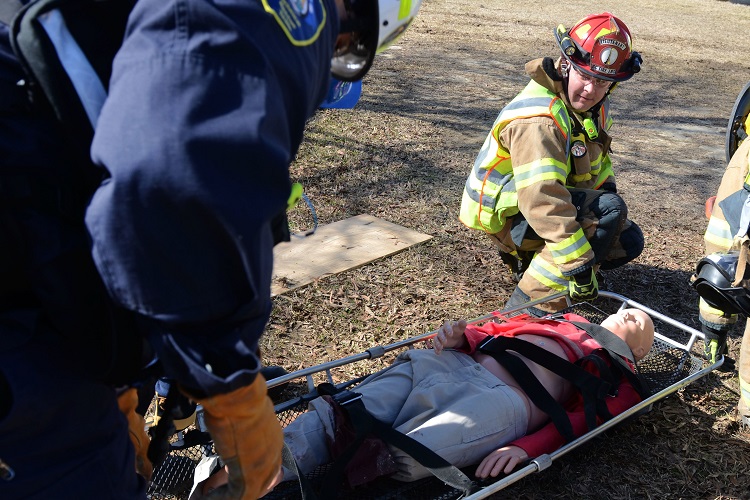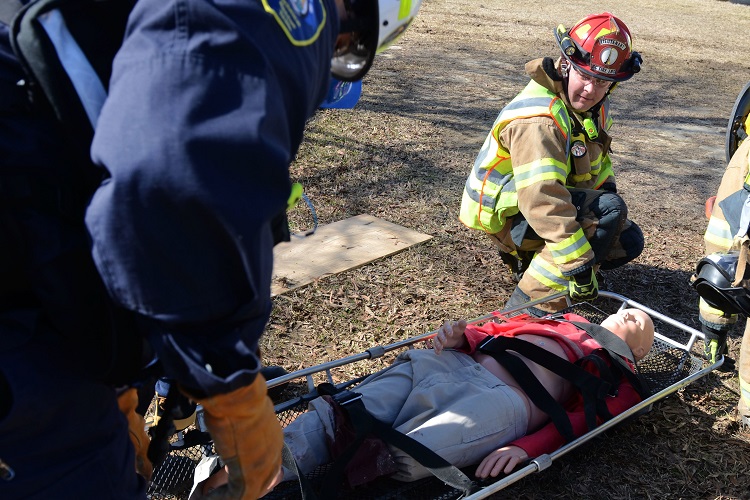

Eric Hemeon, a lieutenant with Georgetown County (SC) Fire/EMS, and members of the Georgetown Tactical Recovery Team work together to lift a simulated patient during a mass casualty and hazardous materials scenario for the Vigilant Guard South Carolina exercise March 8, 2015, at the Choppee Complex in Georgetown, South Carolina. (Photo courtesy of Airman Meghan Floyd.)
By Michael Morse
A good firefighter is a cross-trained firefighter. Members who know how best to be an engine company member AND a ladder company member are imperative to a well-run fire department. Anybody who has donned turnout gear knows this and prides himself on his ability to adapt to whatever task that needs doing on whichever crew. Being assigned to either an engine or a ladder is great, and it is always prudent to cross-train whenever the opportunity is available.
Good firefighters are also good emergency medical technicians (EMTs) and paramedics. It is common for members to develop emergency medical services (EMS) complacency when they are assigned to fire suppression units, but it does not have to be that way. By adding the ambulance to the cross-training schedule, personnel keep their skills (both technical and “people”) sharp where they need to be. As a bonus, firefighters who spend time on the ambulance learn to appreciate a quiet night when they are back on their assigned trucks!
It is difficult to maintain excellence at any task without performing it regularly. The public expects excellence in their fire departments; we have delivered, and will continue to do so. The most impressive thing on an EMS scene is a group of competent firefighters who are adept at EMS. The moments—moments that may be far too long—that a fire crew spends with a patient, his family and friends, or the general public while waiting for an ambulance crew to arrive are best spent treating the patient, not just killing time. Being comfortable assessing a patient and providing treatment does not come from books or lectures—it comes from experience. Doing is far different from learning. Chances are excellent that a week or two of cross-training on an EMS rig will give any firefighter plenty of opportunity to establish IVs, administer oxygen, draw meds, and do some 12-lead EKGs.
One of the most important benefits gained through a fireEMS cross-training program is the improved working relationship between the EMS and fire suppression crews. When I was assigned to Engine Co. 2 in the Providence (RI) Fire Department (PFD), Rescue Co. 3 (PFD calls its EMS ambulances “rescues”) was housed in the bay next to ours. I seldom thought about the ambulance or the people assigned to it, mostly because they were never in the station. Similarly, people assigned to Rescue Co. 3 didn’t give much thought about the fire crews. That was our loss; we never would have understood had we not had the opportunity to do both jobs when a progressive captain implemented EMS cross-training.
RELATED: Marinucci on Fire-Base EMS ‖ Dreyer: EMS Responder Becomes a Patient ‖ Perkins: Are You an EMS Detective?
The call volume for EMS in Providence is triple what the fire crews respond to, but that does not mean the fire crews are loafing around. Housework, training, meals, and fires make for a full shift, something that a lot of EMS crews choose to ignore. Fire crews are famous for considering the EMS crews as being somehow less than themselves. I never took it personally when I was promoted to Rescue Lieutenant and moved to EMS full time, knowing that I was one of the firefighters who did not appreciate EMS until I did it for an extended period.
Spending one or two shifts on the ambulance does not give the full picture of what those people do all day and all night, and why they are always complaining. A full tour is a better “taste,” and two tours in a row are even more so. Being immersed in the ebb and flow of an EMS tour allows a firefighter to experience for himself why those crews respond to calls the way they do and how they handle the call volume. There is less animosity between crews when each understands exactly what the other experiences as a whole, rather than making judgments based on individual calls.
Another reason why cross training with the EMS crews makes sense is it gives the person assigned to the ambulance an opportunity to hone their firefighting skills. Over the course of my EMS career I dressed many a hydrant, flaked thousands of feet of line, helped save an exposure or two, and changed a lot of air bottles. Being a good EMS crew in Providence also meant being good firefighters.
Cross-training with EMS is the right thing to do for everybody involved. Even the most reluctant firefighter will benefit. I certainly did.
More Fire EMS
The Pediatric Call
Assisting with a Combative Patient
Staying Alive During Forcible Entry
To Force or Not to Force Entry
Living or Dead?
 Michael Morse is a captain (Ret.) with the Providence (RI) Fire Department (PFD). He is also the bestselling author of Rescuing Providence, Rescue 1 Responding, City Life, and Mr. Wilson Makes it Home. Morse has been active in emergency medical services (EMS) since 1991 and offers his views on a variety of EMS and firefighting topics, focusing mainly on the interaction between patient and provider. In addition, Morse is a Johnson/Macoll fellow in literature from the Rhode Island Foundation. Follow Morse on Twitter and Facebook. He can also be reached at mmorsepfd@aol.com.
Michael Morse is a captain (Ret.) with the Providence (RI) Fire Department (PFD). He is also the bestselling author of Rescuing Providence, Rescue 1 Responding, City Life, and Mr. Wilson Makes it Home. Morse has been active in emergency medical services (EMS) since 1991 and offers his views on a variety of EMS and firefighting topics, focusing mainly on the interaction between patient and provider. In addition, Morse is a Johnson/Macoll fellow in literature from the Rhode Island Foundation. Follow Morse on Twitter and Facebook. He can also be reached at mmorsepfd@aol.com.

